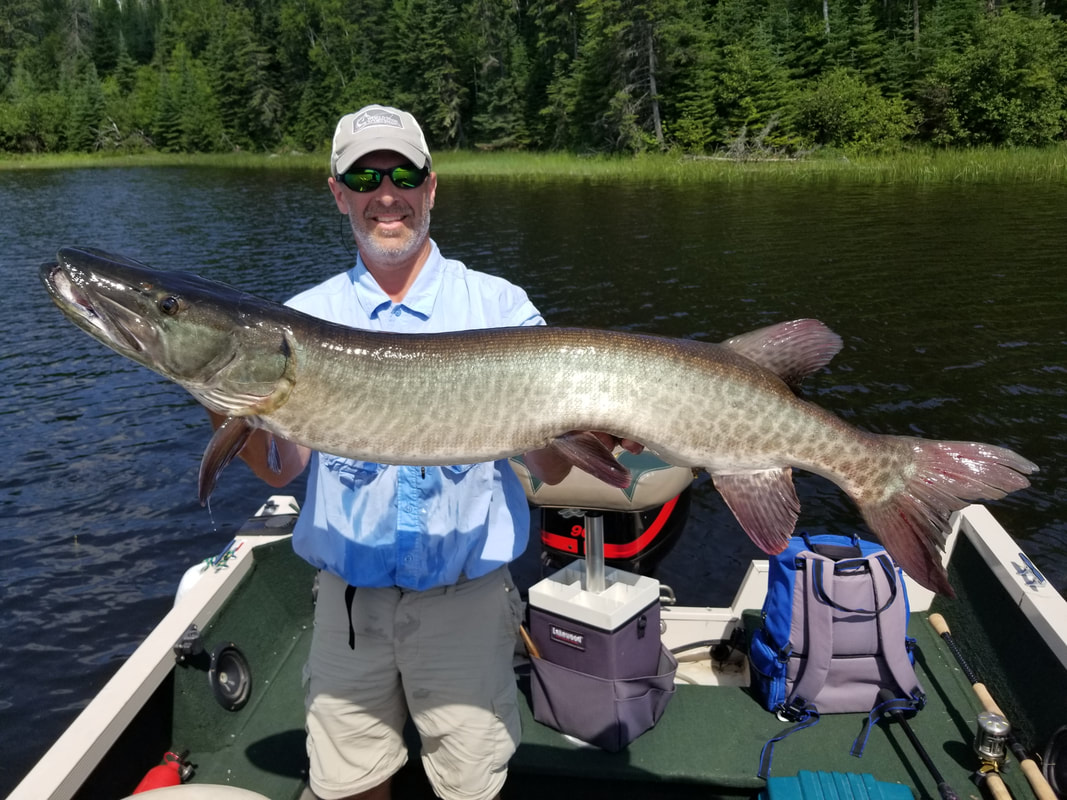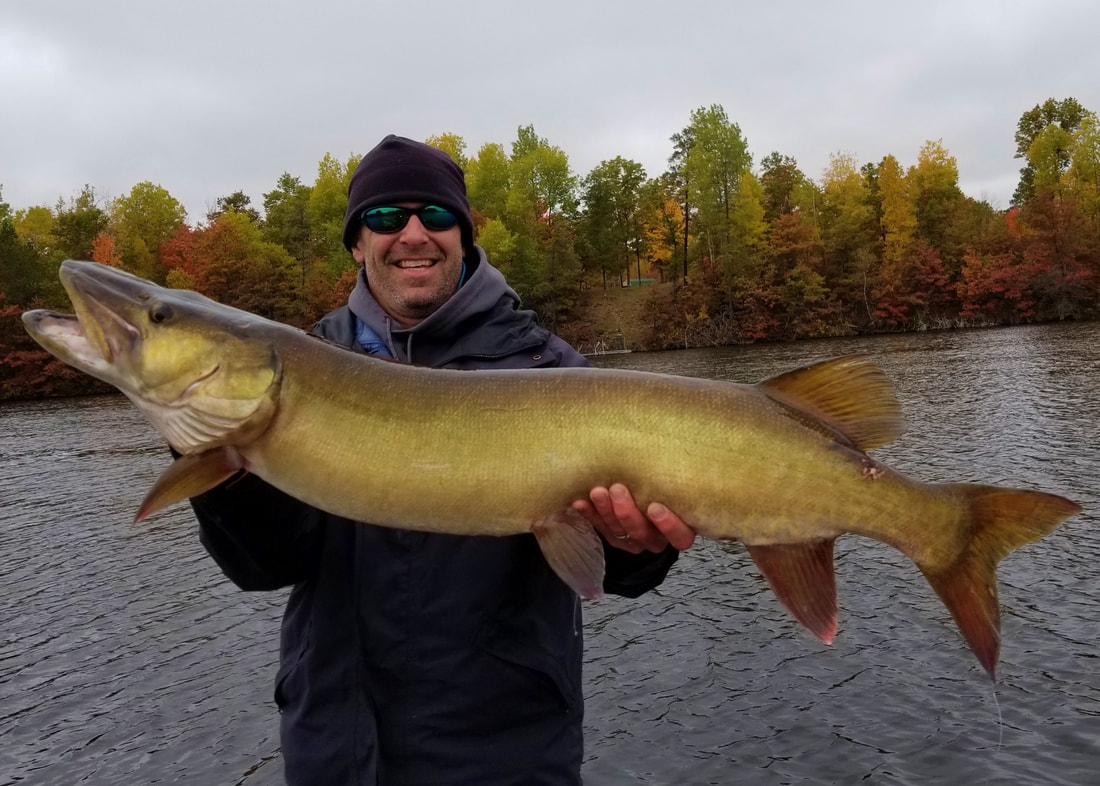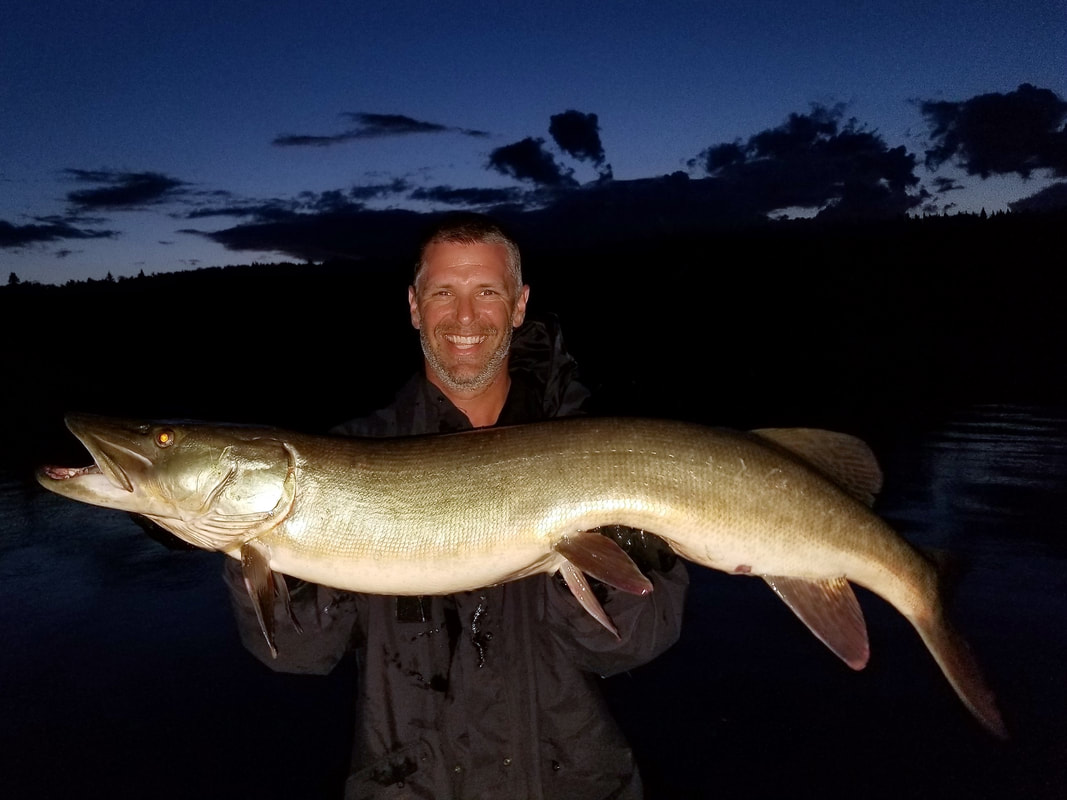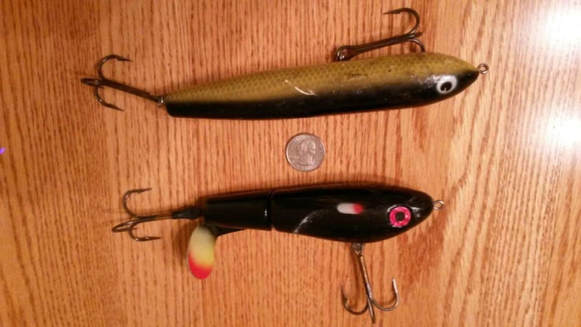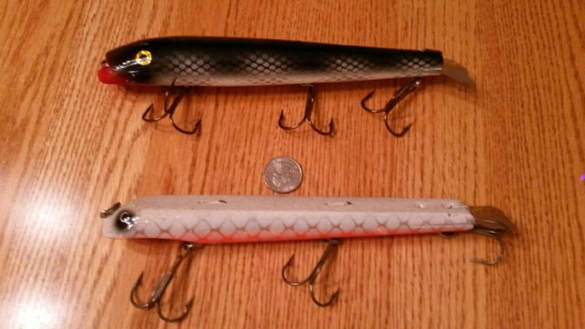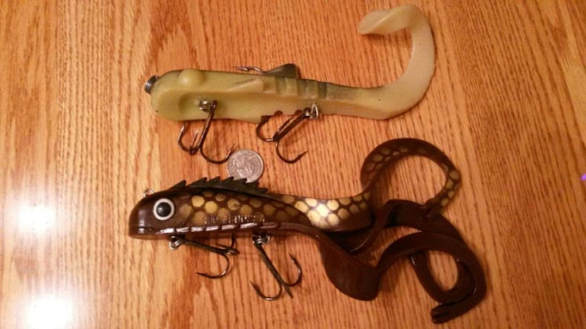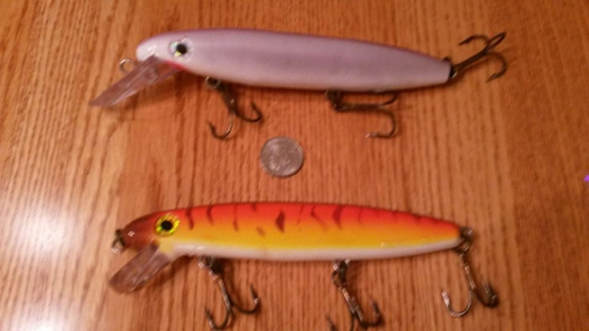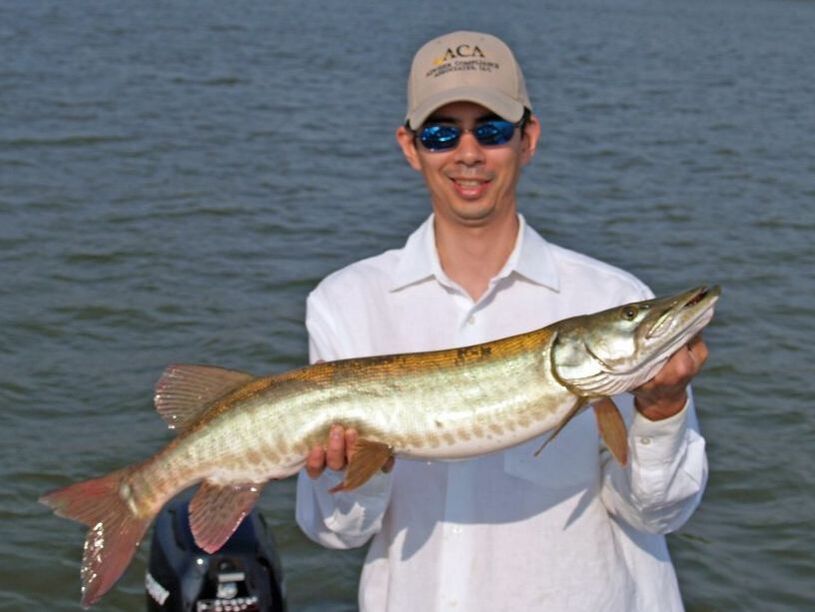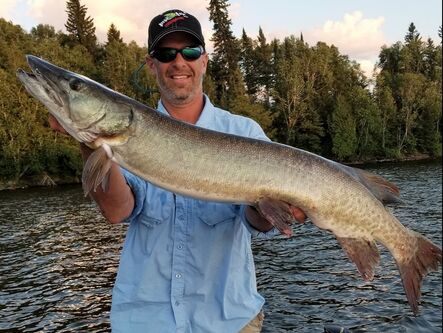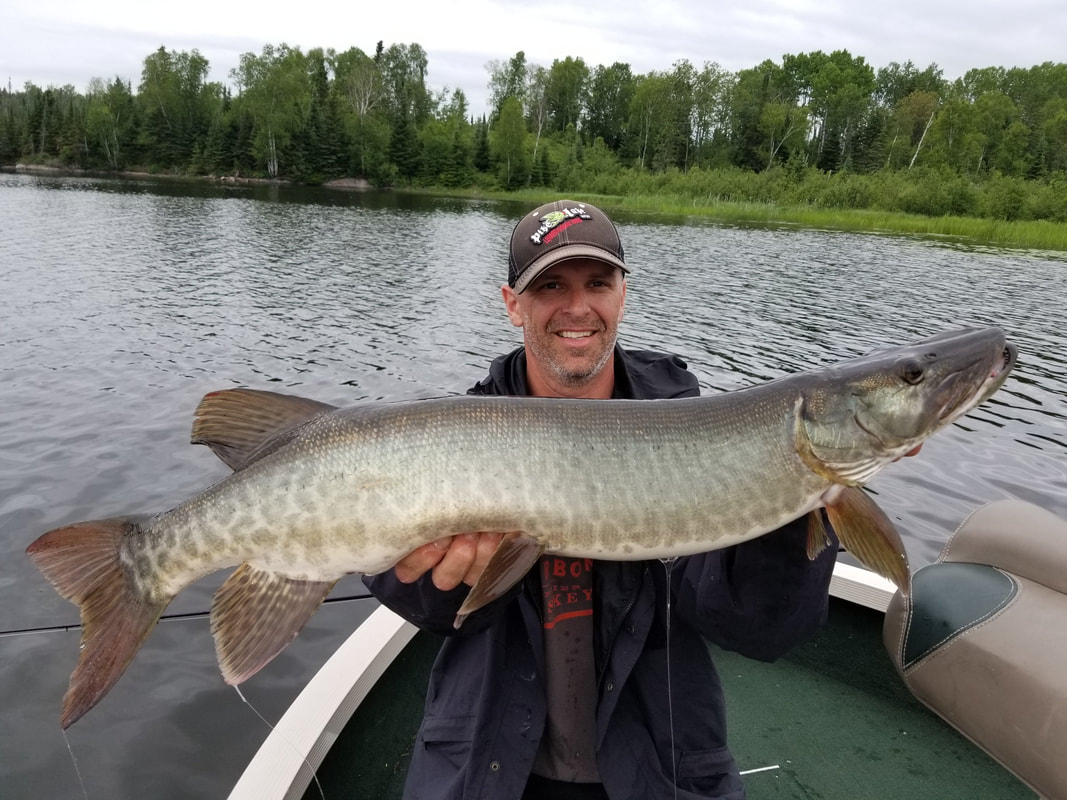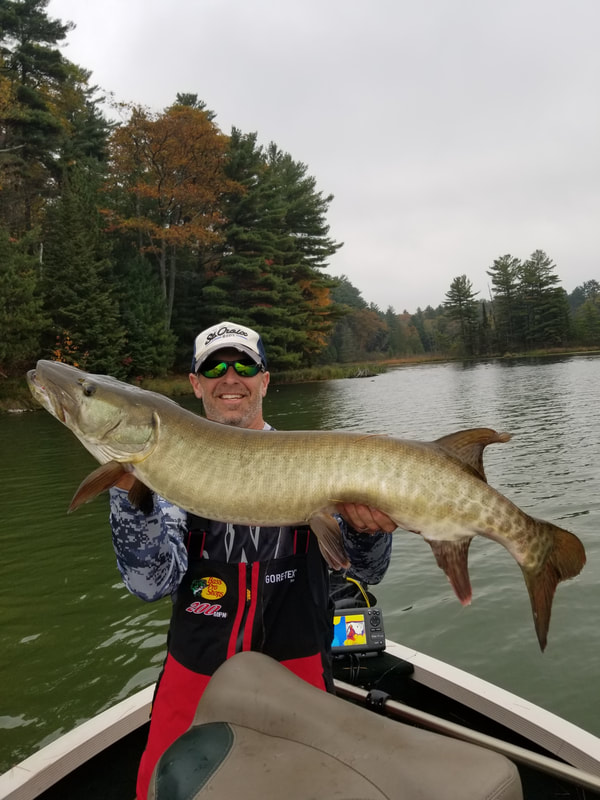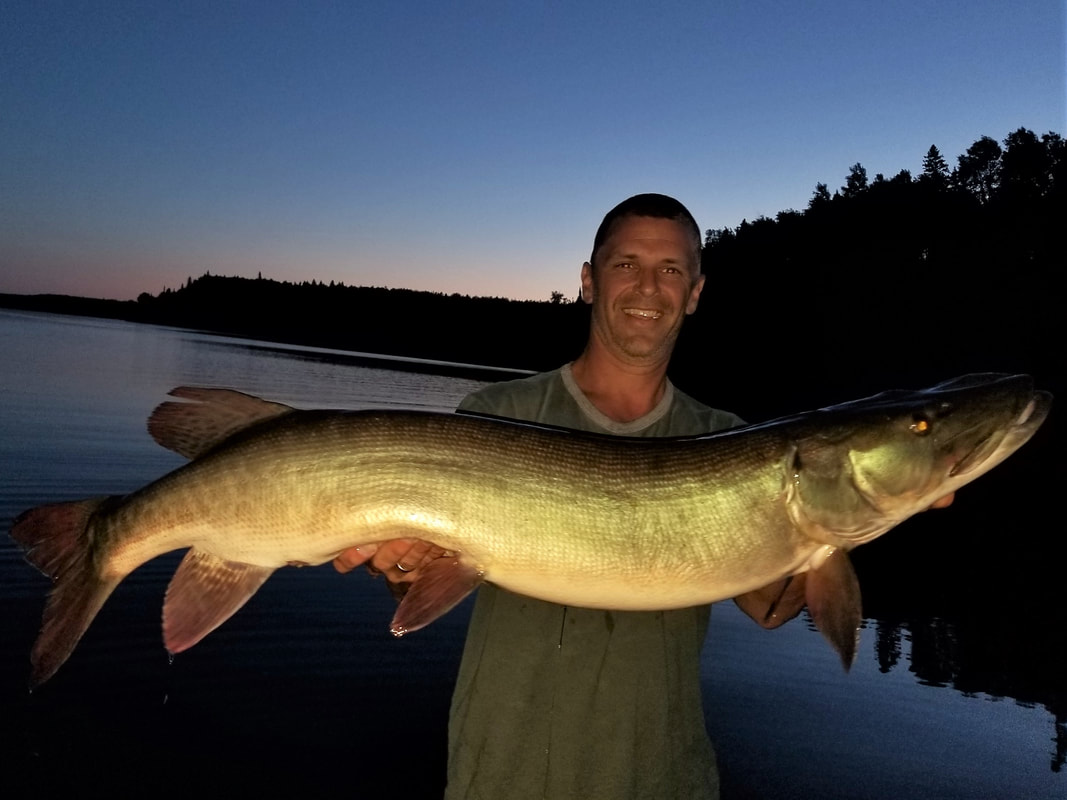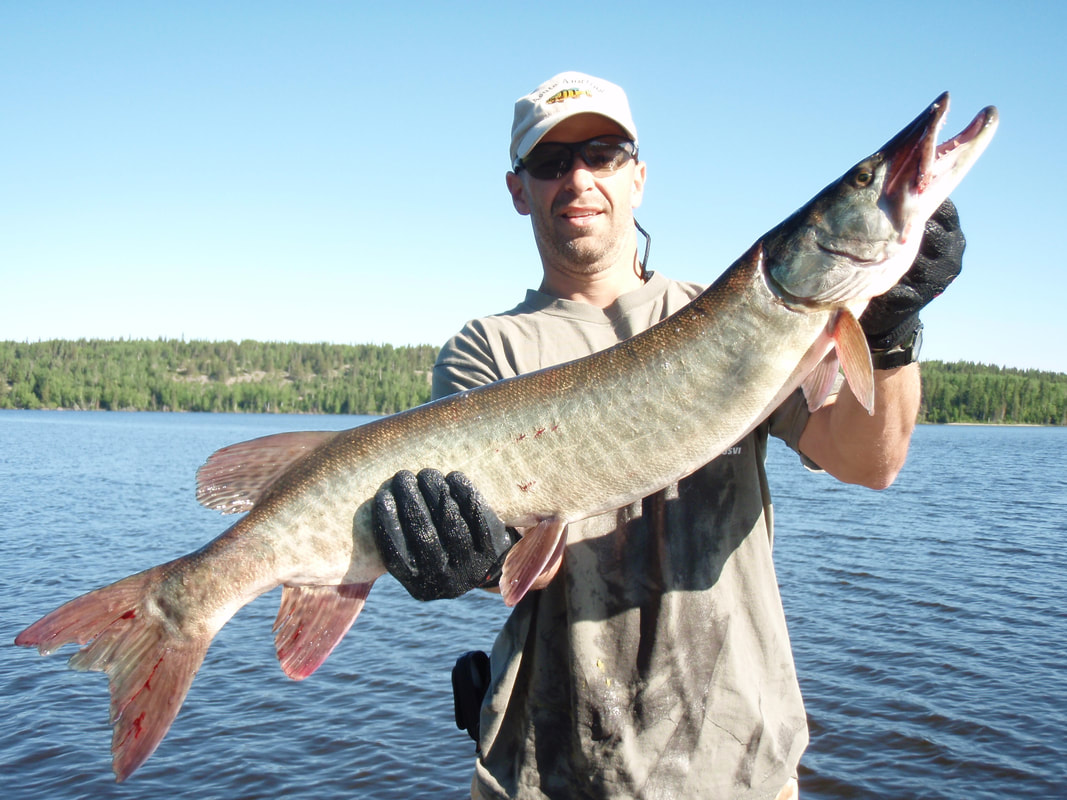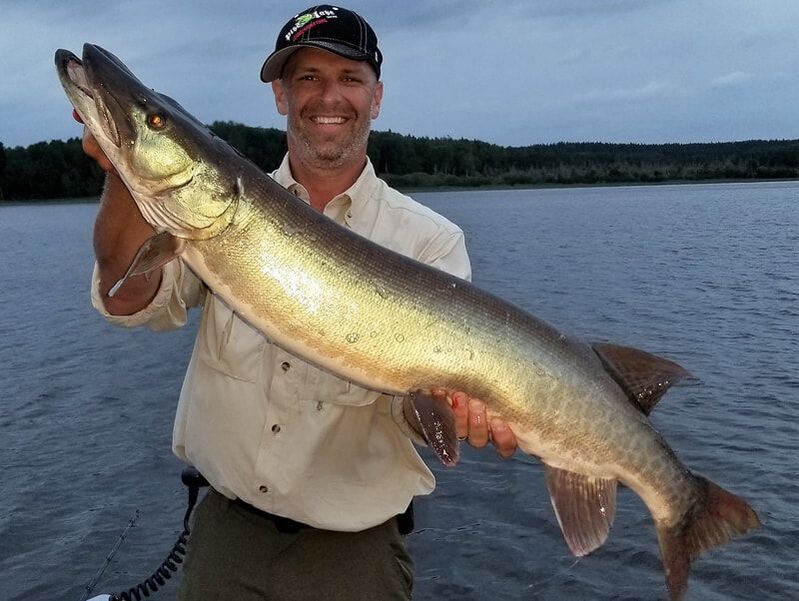Muskie
Esox masquinongy
HOME
Other Species
By Guest Author Gary Nichols
Muskellunge Description
The Muskellunge or Muskie is a close relative of the northern pike, and the largest member of the Pike family. They are ambush predators with a long, relatively thin shape made for speed. Musky are equipped with impressive teeth used to clamp down on and hold prey. Muskellunge will eat nearly anything that swims if it will fit in their mouths. This includes other fish as well as small ducks and mammals. I have caught 15” bass with scars from a close call with a musky, and saw one chasing an 18” walleye that I was reeling in.
Muskellunge can be finicky and may show themselves but refuse to eat. They will often follow a lure to the boat only to turn around and swim away. They seem curious and will follow a lure slowly at a distance without making any attempt to catch it. To me they seem to be thinking “what is that? I better take a closer look”. This is a different approach than their cousin the Northern Pike that seems to think “what is that? I better eat it!”
Muskie are not known as a great food fish and are pursued as a trophy fish. Most muskie fisherman today practice catch and release. With quality replica mounts available at the same price as a skin mount there is really no reason to keep a muskie.
Muskie are usually referred to in inches as opposed to pounds. 50” seems to be a common benchmark for a trophy fish. Although there is some debate on who holds the world record, both fish in contention were around 60” and weighed nearly 70 lbs.
Muskie Pound for Pound Fight Rating - 5.5 out of 10 on the Freshwater Scale
Muskies are usually hooked on relatively heavy tackle, since that is the tackle needed to cast the big lures they eat. As a result, their fights are often a bit underwhelming. They will make some short surges and thrash around, but they are not really powerful fighters. Because of their slender bodies, once you get their heads turned they come to the boat relatively quickly. You just need to be careful they don't spit the hooks with their head shakes. They do get quite large, so just their weight alone can be a challenge, but as noted they are usually hooked on pretty heavy tackle.
Handling and release tips
Large muskies are rare. Proper handling and release techniques are key to ensuring a quality muskie fishery in the future. These fish should be handled carefully so they can breed and produce additional trophy class fish.
Hooked fish should be brought to the net as quickly as possible to prevent over stressing or exhausting it beyond the point it can be released in good condition.
Once in the net, keep the fish in the water so it can breathe while removing hooks. Do not bring it into the boat to work on hook removal. The head and gills should remain in the water. Ensure the gills are not trapped closed by the net.
Always keep your tools handy to reduce the time the fish is in the net or out of the water. Tools should include pliers, and hook cutters. You will be glad you invested in the hook cutters when you end up with one hook in your hand and the other attached to a 30 lb fish.
If a fish is badly hooked, consider cutting the hooks. You may be able to remove cut hooks more easily. If not, the fish has a better chance of survival having a cut hook rust away than having it torn free from the gut or gills.
If you plan on taking a picture, have your camera ready and waiting before removing the fish from the water. Hold the fish horizontally. Holding it vertically out of the water may allow gravity to damage internal organs.
Take pictures quickly and get the fish back into the water. Keep in mind this fish has just fought you to the point of exhaustion and was then pulled into the air where it can’t breathe. This is the equivalent of a person running a wind sprint and then immediately being held under water.
During the release place the fish back into the water and keep hold of the tail or a hand under the belly. Keep the fish upright and hold it in this position while it regains its strength. Do NOT pull the fish back and forth in the water. This forces water the wrong way through the gills and will actually suffocate the fish. Hold the fish until it swims away under its own power. This may take several minutes. Stay in the area for awhile to make sure released fish do not float back to the surface.
Esox masquinongy
HOME
Other Species
By Guest Author Gary Nichols
Muskellunge Description
The Muskellunge or Muskie is a close relative of the northern pike, and the largest member of the Pike family. They are ambush predators with a long, relatively thin shape made for speed. Musky are equipped with impressive teeth used to clamp down on and hold prey. Muskellunge will eat nearly anything that swims if it will fit in their mouths. This includes other fish as well as small ducks and mammals. I have caught 15” bass with scars from a close call with a musky, and saw one chasing an 18” walleye that I was reeling in.
Muskellunge can be finicky and may show themselves but refuse to eat. They will often follow a lure to the boat only to turn around and swim away. They seem curious and will follow a lure slowly at a distance without making any attempt to catch it. To me they seem to be thinking “what is that? I better take a closer look”. This is a different approach than their cousin the Northern Pike that seems to think “what is that? I better eat it!”
Muskie are not known as a great food fish and are pursued as a trophy fish. Most muskie fisherman today practice catch and release. With quality replica mounts available at the same price as a skin mount there is really no reason to keep a muskie.
Muskie are usually referred to in inches as opposed to pounds. 50” seems to be a common benchmark for a trophy fish. Although there is some debate on who holds the world record, both fish in contention were around 60” and weighed nearly 70 lbs.
Muskie Pound for Pound Fight Rating - 5.5 out of 10 on the Freshwater Scale
Muskies are usually hooked on relatively heavy tackle, since that is the tackle needed to cast the big lures they eat. As a result, their fights are often a bit underwhelming. They will make some short surges and thrash around, but they are not really powerful fighters. Because of their slender bodies, once you get their heads turned they come to the boat relatively quickly. You just need to be careful they don't spit the hooks with their head shakes. They do get quite large, so just their weight alone can be a challenge, but as noted they are usually hooked on pretty heavy tackle.
Handling and release tips
Large muskies are rare. Proper handling and release techniques are key to ensuring a quality muskie fishery in the future. These fish should be handled carefully so they can breed and produce additional trophy class fish.
Hooked fish should be brought to the net as quickly as possible to prevent over stressing or exhausting it beyond the point it can be released in good condition.
Once in the net, keep the fish in the water so it can breathe while removing hooks. Do not bring it into the boat to work on hook removal. The head and gills should remain in the water. Ensure the gills are not trapped closed by the net.
Always keep your tools handy to reduce the time the fish is in the net or out of the water. Tools should include pliers, and hook cutters. You will be glad you invested in the hook cutters when you end up with one hook in your hand and the other attached to a 30 lb fish.
If a fish is badly hooked, consider cutting the hooks. You may be able to remove cut hooks more easily. If not, the fish has a better chance of survival having a cut hook rust away than having it torn free from the gut or gills.
If you plan on taking a picture, have your camera ready and waiting before removing the fish from the water. Hold the fish horizontally. Holding it vertically out of the water may allow gravity to damage internal organs.
Take pictures quickly and get the fish back into the water. Keep in mind this fish has just fought you to the point of exhaustion and was then pulled into the air where it can’t breathe. This is the equivalent of a person running a wind sprint and then immediately being held under water.
During the release place the fish back into the water and keep hold of the tail or a hand under the belly. Keep the fish upright and hold it in this position while it regains its strength. Do NOT pull the fish back and forth in the water. This forces water the wrong way through the gills and will actually suffocate the fish. Hold the fish until it swims away under its own power. This may take several minutes. Stay in the area for awhile to make sure released fish do not float back to the surface.
Muskellunge Tackle
Muskie fishing requires fairly heavy duty gear. This is not only due to the size and weights that they can attain, but also for throwing the heavy lures generally used when chasing them. Heavy action Casting rods in the 8’ range are pretty standard with recent trends calling for even longer rods. This helps with casting heavy baits, and for performing boat side figure eights when fish are following but have not yet taken the lure. You may want to go lighter (MH) or as heavy as XXH depending on the type and size of the lures you intend to throw. There are a number of quality rod companies, but I am partial to St Croix rods. The rod should be paired with a quality 300 – 400 series bait casting reel. I personally prefer a higher gear ratio (6.3 or faster) with around 25-30” of line retrieved per handle turn. My thought is that with a fast reel you can always slow down your retrieve if necessary. It is difficult and tiring to try to burn a lure quickly with a slow reel when throwing large lures all day. Shimano, Daiwa, and Abu Garcia all make quality reels suitable for muskie fishing. There are several other companies that I’m sure make quality reels, but I have personally owned and used all of the above with few complaints.
Reels should be spooled with braided line. I use 80 lb line on my standard set ups, with 65 lb for the spring when I tend to use downsized lures. This may seem like overkill, but muskies have a knack for finding things to wrap your line around. Often times this is close quarters combat with the strike coming at the side of the boat with trolling motors, props, etc in the vicinity. The heavy line also keeps you from losing $30-$40 lures when you get snagged. I like Power Pro as it doesn’t seem to absorb as much water as some other brands. I am often fishing in cold weather and this helps keep my hands from getting wet/cold as quickly.
Because of muskies sharp teeth, leaders are a must. 12” Solid wire or heavy fluorocarbon leaders rated at a minimum of 100 # will work for most applications. Quality snap attachments or split rings of the same weight rating or better should be used to attach lures to the leader.
Muskie fishing requires fairly heavy duty gear. This is not only due to the size and weights that they can attain, but also for throwing the heavy lures generally used when chasing them. Heavy action Casting rods in the 8’ range are pretty standard with recent trends calling for even longer rods. This helps with casting heavy baits, and for performing boat side figure eights when fish are following but have not yet taken the lure. You may want to go lighter (MH) or as heavy as XXH depending on the type and size of the lures you intend to throw. There are a number of quality rod companies, but I am partial to St Croix rods. The rod should be paired with a quality 300 – 400 series bait casting reel. I personally prefer a higher gear ratio (6.3 or faster) with around 25-30” of line retrieved per handle turn. My thought is that with a fast reel you can always slow down your retrieve if necessary. It is difficult and tiring to try to burn a lure quickly with a slow reel when throwing large lures all day. Shimano, Daiwa, and Abu Garcia all make quality reels suitable for muskie fishing. There are several other companies that I’m sure make quality reels, but I have personally owned and used all of the above with few complaints.
Reels should be spooled with braided line. I use 80 lb line on my standard set ups, with 65 lb for the spring when I tend to use downsized lures. This may seem like overkill, but muskies have a knack for finding things to wrap your line around. Often times this is close quarters combat with the strike coming at the side of the boat with trolling motors, props, etc in the vicinity. The heavy line also keeps you from losing $30-$40 lures when you get snagged. I like Power Pro as it doesn’t seem to absorb as much water as some other brands. I am often fishing in cold weather and this helps keep my hands from getting wet/cold as quickly.
Because of muskies sharp teeth, leaders are a must. 12” Solid wire or heavy fluorocarbon leaders rated at a minimum of 100 # will work for most applications. Quality snap attachments or split rings of the same weight rating or better should be used to attach lures to the leader.
Muskellunge Techniques
Muskies are generally caught by casting artificial lures, however there is a growing number of anglers targeting them by trolling. When casting it is important not to simply bring the lure back into the boat after your retrieve. You should leave the lure in the water next to the boat while moving the lure in the shape of a figure eight. This gives fish that were following at a distance time to catch up to the lure, and the sudden direction change is often what triggers the strike. Fishing live suckers on a quick strike rig can also be very effective. Live bait is usually more effective in the fall as the cooler water allows the sucker to stay active and lively longer. Fishermen using live bait often use it in conjunction with casting artificials. The sucker is left hanging over the side of the boat while another rod is cast. Fish that follow the lure to the boat but do not strike may be more interested in the live bait and take that instead.
Muskie habitat varies depending on the lake you are fishing. A well defined weed edge is a good starting point. In rivers, current breaks and eddies should be fished. If you are on a lake with little weed cover such as some of the Canadian shield lakes, walleye habitat such as rock reefs, and windblown points are good bets. In deeper lakes or those with ciscoes, muskies will suspend in deep water following those bait schools.
Muskellunge Lures
There are an unbelievable number of lures used for muskie fishing and far too many to list here. Some of the must haves are inline or bucktail spinners, walk the dog or propeller style topwaters, dive and rise style jerkbaits, glide baits, rubber swim/pullbaits, and large crankbaits. Rollie and Helens Musky Shop has everything you could possibly think of to throw at a muskie. www.muskyshop.com
Muskies are generally caught by casting artificial lures, however there is a growing number of anglers targeting them by trolling. When casting it is important not to simply bring the lure back into the boat after your retrieve. You should leave the lure in the water next to the boat while moving the lure in the shape of a figure eight. This gives fish that were following at a distance time to catch up to the lure, and the sudden direction change is often what triggers the strike. Fishing live suckers on a quick strike rig can also be very effective. Live bait is usually more effective in the fall as the cooler water allows the sucker to stay active and lively longer. Fishermen using live bait often use it in conjunction with casting artificials. The sucker is left hanging over the side of the boat while another rod is cast. Fish that follow the lure to the boat but do not strike may be more interested in the live bait and take that instead.
Muskie habitat varies depending on the lake you are fishing. A well defined weed edge is a good starting point. In rivers, current breaks and eddies should be fished. If you are on a lake with little weed cover such as some of the Canadian shield lakes, walleye habitat such as rock reefs, and windblown points are good bets. In deeper lakes or those with ciscoes, muskies will suspend in deep water following those bait schools.
Muskellunge Lures
There are an unbelievable number of lures used for muskie fishing and far too many to list here. Some of the must haves are inline or bucktail spinners, walk the dog or propeller style topwaters, dive and rise style jerkbaits, glide baits, rubber swim/pullbaits, and large crankbaits. Rollie and Helens Musky Shop has everything you could possibly think of to throw at a muskie. www.muskyshop.com
Where to get the big Muskellunge
Wisconsin, Michigan, Minnesota, and Ontario all have plenty of musky water. As a proud cheesehead I feel obligated to mention the two biggest fish on record were both from WI. The adage big water – big fish does seem to hold true with musky. The bay of Green Bay, Lake St Clair, and Lake of the Woods are a few well known waters with a reputation for big fish. Another recipe for finding big fish is to find the lakes that have ciscoes or other higher calorie forage fish. Muskies that are on a steady diet of ciscoes are going to get bigger, and reach larger sizes faster, than fish that are eating perch or other panfish.
Other Muskellunge Resources
The above barely scratches the surface on how to catch Muskellunge. The resources below will provide a wealth of information:
https://muskiesinc.org/
http://www.muskyhunter.com/
Wisconsin, Michigan, Minnesota, and Ontario all have plenty of musky water. As a proud cheesehead I feel obligated to mention the two biggest fish on record were both from WI. The adage big water – big fish does seem to hold true with musky. The bay of Green Bay, Lake St Clair, and Lake of the Woods are a few well known waters with a reputation for big fish. Another recipe for finding big fish is to find the lakes that have ciscoes or other higher calorie forage fish. Muskies that are on a steady diet of ciscoes are going to get bigger, and reach larger sizes faster, than fish that are eating perch or other panfish.
Other Muskellunge Resources
The above barely scratches the surface on how to catch Muskellunge. The resources below will provide a wealth of information:
https://muskiesinc.org/
http://www.muskyhunter.com/
